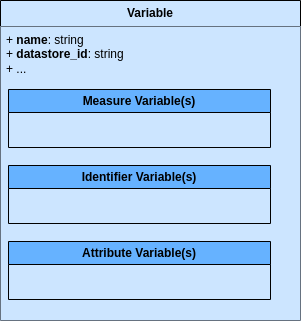Variables and Metadata
The metadata elements describing a Variable can be inferred from the (simplified) Instance Variable conceptual model shown below:

We can then represent this using a Python schema as follows:
class SingleVariableDataset:
name: str
datastore_id: str
populationDescription: list[Description]
subjectFields: list[str]
temporalCoverage: ValidPeriod
temporality: str
spatialCoverageDescription: list[Description]
sensitivityLevel: str
updatedAt: datetime
identifierVariables: list[IdentifierVariable]
measureVariable: MeasureVariable
attributeVariables: list[AttributeVariable]
Notice how the three properties (measure, attribute, identifier) which describe the Data Point in the model above are represented in the schema by embedded data structures.

They are of three types:
- Measure Variables: Metadata describing WHAT is MEASURED by this particular datum, and HOW.
- Identifier Variables: Metadata describing WHAT uniquely IDENTIFIES this particular datum, and HOW.
- Attribute Variables: Metadata describing other attributes, especially TEMPORAL, which are relevant about this particular datum.
Variable naming guidelines
The name of a Variable should:
- Describe what the datum is measuring
- Consist of a single string in capital letters, made up of keywords separated by underscores (
_). - In line with the Kudaf objective to maximize data-sharing potential, it would be preferrable to write the keywords in English.
- It must be the same as the name of the Measure Variable data structure within the Variable.
- The name must be UNIQUE within the set of Variables from a given data source.
How to choose the keywords in the Variable's name:
- The 1st keyword (before the first underscore) in the name indicates the data source. Examples:
- Feide public API: "FEIDEAPI"
- Feide Statistics database: "FEIDESTATS"
- Lånekasen: "LK"
- The 2nd keyword (or group of keywords) should summarize what the variable is measuring. Examples:
- School names: "SCHOOL_NAMES" (in this case not technically a "measure", more of a qualifier)
- Login event counts: "LOGINS"
- Multi-factor authentication event counts: "MFAS"
- The 3rd keyword (or group of keywords) should point out the unique identifier(s) of the Variable. Examples:
- If the login event counts are accumulated for each organization: "ORG"
- If the multi-factor authentication event counts are accumulated for each combination of organization and authentication method: "ORG_METHOD"
- The last keyword (if present) can indicate the variable's temporality:
- If the temporality type is "FIXED", we can omit it.
- Otherwise for the other temporality types, choose one of: "ACCUM", "STATUS", "EVENT".
A complete example from the above could be "FEIDESTATS_LOGINS_ORG_SP_ACCUM". This Variable would thus refer to data that:
- Comes from the Feide Statistics data source.
- Measures login event counts.
- Each measure is identified by an organization and a service provicder.
- The measures (login event counts) are accumulated over a given time period.